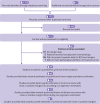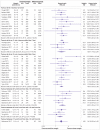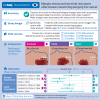Margin status and survival outcomes after breast cancer conservation surgery: prospectively registered systematic review and meta-analysis
- PMID: 36130770
- PMCID: PMC9490551
- DOI: 10.1136/bmj-2022-070346
Margin status and survival outcomes after breast cancer conservation surgery: prospectively registered systematic review and meta-analysis
Abstract
Objective: To determine if margin involvement is associated with distant recurrence and to determine the required margin to minimise both local recurrence and distant recurrence in early stage invasive breast cancer.
Design: Prospectively registered systematic review and meta-analysis of literature.
Data sources: Medline (PubMed), Embase, and Proquest online databases. Unpublished data were sought from study authors.
Eligibility criteria: Eligible studies reported on patients undergoing breast conserving surgery (for stages I-III breast cancer), allowed an estimation of outcomes in relation to margin status, and followed up patients for a minimum of 60 months. Patients with ductal carcinoma in situ only or treated with neoadjuvant chemotherapy or by mastectomy were excluded. Where applicable, margins were categorised as tumour on ink (involved), close margins (no tumour on ink but <2 mm), and negative margins (≥2 mm).
Results: 68 studies from 1 January 1980 to 31 December 2021, comprising 112 140 patients with breast cancer, were included. Across all studies, 9.4% (95% confidence interval 6.8% to 12.8%) of patients had involved (tumour on ink) margins and 17.8% (13.0% to 23.9%) had tumour on ink or a close margin. The rate of distant recurrence was 25.4% (14.5% to 40.6%) in patients with tumour on ink, 8.4% (4.4% to 15.5%) in patients with tumour on ink or close, and 7.4% (3.9% to 13.6%) in patients with negative margins. Compared with negative margins, tumour on ink margins were associated with increased distant recurrence (hazard ratio 2.10, 95% confidence interval 1.65 to 2.69, P<0.001) and local recurrence (1.98, 1.66 to 2.36, P<0.001). Close margins were associated with increased distant recurrence (1.38, 1.13 to 1.69, P<0.001) and local recurrence (2.09, 1.39 to 3.13, P<0.001) compared with negative margins, after adjusting for receipt of adjuvant chemotherapy and radiotherapy. In five studies published since 2010, tumour on ink margins were associated with increased distant recurrence (2.41, 1.81 to 3.21, P<0.001) as were tumour on ink and close margins (1.44, 1.22 to 1.71, P<0.001) compared with negative margins.
Conclusions: Involved or close pathological margins after breast conserving surgery for early stage, invasive breast cancer are associated with increased distant recurrence and local recurrence. Surgeons should aim to achieve a minimum clear margin of at least 1 mm. On the basis of current evidence, international guidelines should be revised.
Systematic review registration: CRD42021232115.
© Author(s) (or their employer(s)) 2019. Re-use permitted under CC BY-NC. No commercial re-use. See rights and permissions. Published by BMJ.
Conflict of interest statement
Competing interests: All authors have completed the ICMJE uniform disclosure form at www.icmje.org/disclosure-of-interest/ and declare: no support from any organisation for the submitted work; no financial relationships with any organisations that might have an interest in the submitted work in the previous three years; NJB received a National Institute for Health and Care Research, Research for Patient Benefit grant investigating a margin device. The authors declare no other relationships or activities that could appear to have influenced the submitted work.
Figures




References
-
- Kennedy I. Review of the response of Heart of England NHS Foundation Trust to concerns about Mr I Paterson’s Surgical Practice: lessons to be learned and recommendations. (2013).
-
- McGale P, Taylor C, Correa C, et al. EBCTCG (Early Breast Cancer Trialists’ Collaborative Group) . Effect of radiotherapy after mastectomy and axillary surgery on 10-year recurrence and 20-year breast cancer mortality: meta-analysis of individual patient data for 8135 women in 22 randomised trials. Lancet 2014;383:2127-35. 10.1016/S0140-6736(14)60488-8 - DOI - PMC - PubMed
-
- Buchholz TA, Somerfield MR, Griggs JJ, et al. Margins for breast-conserving surgery with whole-breast irradiation in stage I and II invasive breast cancer: American Society of Clinical Oncology endorsement of the Society of Surgical Oncology/American Society for Radiation Oncology consensus guideline. J Clin Oncol 2014;32:1502-6. 10.1200/JCO.2014.55.1572 - DOI - PubMed
-
- National Institute for Clinical Excellence. NG101: Early and locally advanced breast cancer: diagnosis and management. (2018).
Publication types
MeSH terms
LinkOut - more resources
Full Text Sources
Medical
